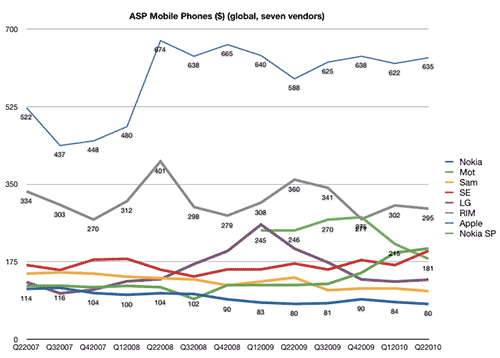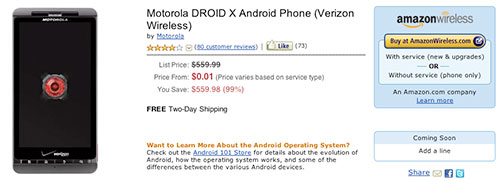The Importance of Average Selling Price
Comparing prices of mobile phones is difficult. I was reminded of this fact recently when I saw Amazon’s price for the Droid X: 1 cent.
At launch, the Droid X cost $199 with a two-year commitment. Amazon originally offered the Droid X for a penny in November—only four months after the phone was released.
That’s a tremendous phone for a penny.
But the point of this post isn’t to convince you that this is a great deal. Instead, I wanted to look at the challenges of trying to compare mobile phone products based on price.
Last summer, there were numerous articles comparing the Droid X to the iPhone 4. Nearly every article noted that they cost the same price with a two-year contract.
But while the iPhone 4 continues to sell at $199, someone who waited a few months to buy a Droid X can save quite a bit of money.
This illustrates some of the problems that come from trying to compare mobile prices. For example:
- Every new product is judged against the comparable Apple product. However, these comparisons only occur at the time the products are launched, not in the subsequent months when the price decreases. Apple is the only company that maintains the product price until a new model is ready to replace the old one.
- Apple also uses a minimum advertised price policy to prevent retailers from selling products at a steep discount. Most other companies allow retailers to discount their products which means consumers can find deals.
- Carrier subsidies distort the market. They fluctuate from product to product and over time depending on what the carrier and the handset manufacturer negotiate. And carrier subsidies do not exist in every country which means that the U.S. view of the relative prices of phones will differ from those in countries without subsidies.
Because these factors make it difficult to compare the price of phones, I don’t pay much attention to the price that new products are released at. Instead, I look at the average selling price to get a sense of the “real” price of the handsets.
The Average Selling Price
The average selling price (ASP) tell us how much money a handset manufacturer is receiving on average for the phones that it sells. The average selling price is usually reported during quarterly financial results and thus can be considered as accurate as possible given regulation on fraudulent reporting.
Horace Dediu of Asymco recently charted the ASP for major handset manufacturers.

Looking at this chart, it becomes clear the Apple is still selling at the high end of the smart phone market. The average selling price for the iPhone is $635. The nearest competitor is RIM with an ASP that is half of the iPhone ($295).
Even if I’m walking out of the store with a new iPhone for $199, someone is ultimately paying $635 for that phone. And my suspicion is that the person ultimately paying that price is the consumer.
This is why the average selling price is probably our best metric for comparing how much companies are really charging for their phones over the life of their products.
Averaging selling price helps get rid of the distortion of the carrier subsidies and inflated MSRP which only the few customers who buy immediately at launch have to pay. ASP instead shows the “real” price that manufacturers are getting for their phones which makes it easier to compare true costs.

Jason Grigsby is one of the co-founders of Cloud Four, Mobile Portland and Responsive Field Day. He is the author of Progressive Web Apps from A Book Apart. Follow him at @grigs.
